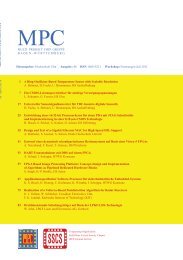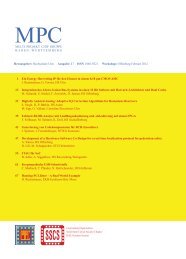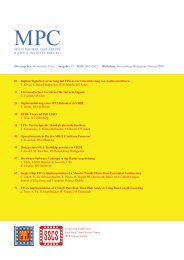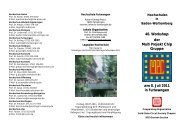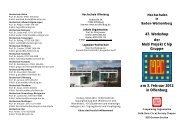Workshopband als PDF - Mpc.belwue.de
Workshopband als PDF - Mpc.belwue.de
Workshopband als PDF - Mpc.belwue.de
Sie wollen auch ein ePaper? Erhöhen Sie die Reichweite Ihrer Titel.
YUMPU macht aus Druck-PDFs automatisch weboptimierte ePaper, die Google liebt.
MPC-WORKSHOP FEBRUAR 2013<br />
• Add shared libraries to the source co<strong>de</strong> and make<br />
a custom port to Android (cf. ch. B.1)).<br />
• Use the Android Open Accessory Mo<strong>de</strong> (cf.<br />
ch. B.2)).<br />
• Use external MCUs connected over USB or Bluetooth<br />
(cf. ch. B.3)).<br />
B. Accessing local interfaces from Android<br />
1) Android Porting<br />
This solution requires adding the nee<strong>de</strong>d hardware<br />
drivers to the Linux kernel and applying the Android<br />
patch to the kernel as a first step. As a second step, the<br />
shared libraries should be ma<strong>de</strong> available in the source<br />
co<strong>de</strong> of Android. This custom version must then be<br />
ported to the target <strong>de</strong>vice. The best part of this approach<br />
is that after the accomplishment of this task<br />
only application level programming would be required<br />
to make use of these peripher<strong>als</strong> like the USB and<br />
WiFi APIs are used in Android normally. The downturn<br />
of this approach is that <strong>de</strong>tailed knowledge of the<br />
hardware would be required, which mostly calls for<br />
support from the hardware vendor.<br />
Generally speaking, this approach fundamentally<br />
contradicts the overall Android approach, which<br />
strives to avoid complex Linux programming and tries<br />
to replace it with comparatively easier Java programming.<br />
In the end this approach would double the work,<br />
because first Linux programmers would build their<br />
own build of Android to inclu<strong>de</strong> the libraries in the OS<br />
and then the Java <strong>de</strong>velopers would use these libraries<br />
in the application <strong>de</strong>velopment phase. This would <strong>als</strong>o<br />
increase the initial <strong>de</strong>velopment cycle of the product<br />
but with a much more stable result.<br />
2) Android Open Accessory Mo<strong>de</strong><br />
The second option to add hardware interfaces comes<br />
from the Android Open Accessory mo<strong>de</strong>, which allows<br />
the connection of peripher<strong>als</strong> to an Android platform<br />
where the Android is the USB <strong>de</strong>vice and the<br />
peripheral (accessory) is the USB host [6]. This avoids<br />
the necessity of new hardware drivers.<br />
Google implemented its own hardware by the name<br />
Android Accessory Development Kit (ADK) as a<br />
reference implementation to build hardware accessories<br />
for Android. The ADK is based on the Arduino<br />
open source electronics prototyping platform [12].<br />
Android Open Accessory [13] protocol is used to<br />
communicate with the Android <strong>de</strong>vice over a USB or<br />
a Bluetooth connection. This mo<strong>de</strong> is not supported on<br />
a lot of <strong>de</strong>vices and as reported by various senior <strong>de</strong>velopers<br />
on communities it is not so robust [14].<br />
3) External Microcontrollers<br />
The third possible solution is very similar to the one<br />
used by Google for their Google ADK. It uses the<br />
USB or Bluetooth interfaces of the Android <strong>de</strong>vice to<br />
attach an external MCU, where the MCU implements<br />
and provi<strong>de</strong>s the actual connectivity to the local interfaces.<br />
There are external boards already available on<br />
the market, like the FT311D from FTDI [15] or the<br />
IOIO from Sparkfun [16]. These boards are <strong>de</strong>livered<br />
with a custom API library which may be inclu<strong>de</strong>d into<br />
an Android application and provi<strong>de</strong>s access to the<br />
boards peripher<strong>als</strong>. The good si<strong>de</strong> is that for these<br />
boards the <strong>de</strong>velopment time <strong>de</strong>creases consi<strong>de</strong>rably,<br />
compared to integrating Linux drivers.<br />
C. Evaluation of methods to access local interfaces<br />
If a company <strong>de</strong>velops their own board and ports<br />
Android on their own, then they will write their own<br />
drivers for their system. This is the best way to offer<br />
these interfaces to the application. If a company wants<br />
to use an off the shelf board with Android already<br />
running on it but the required interfaces are missing,<br />
the Android Open Accessory Mo<strong>de</strong> or the external<br />
MCU approach will be the approach with less effort.<br />
The latter use case is interesting for this investigation<br />
because the TechNexion board does not support the<br />
drivers nee<strong>de</strong>d for the hardware. Furthermore the<br />
ADK is not or<strong>de</strong>rable. Therefore, it was <strong>de</strong>ci<strong>de</strong>d to go<br />
with the external MCU approach as a solution to add<br />
peripheral support to Android. The IOIO board was<br />
used for this work.<br />
The board is created by a day-time Google employee<br />
as a hobby project and is sold by Sparkfun. The board<br />
connects to the Android <strong>de</strong>vice in <strong>de</strong>bug mo<strong>de</strong> using<br />
USB OTG or Bluetooth. An Android application can<br />
utilize the IOIO libraries to access functionalities on<br />
the board. No embed<strong>de</strong>d programming is required.<br />
Another good thing is that it works with all Android<br />
versions above 1.5.<br />
VI. HARDWARE FOR THE TARGET SYSTEM<br />
The target platform requires a lot of hardware interfaces<br />
to work. In this section each interface will be<br />
discussed one after the other.<br />
A. Tsunami Mainboard<br />
1) SD-Card<br />
As large memory storage is required to store logged<br />
data, an SD-Card could easily solve this requirement.<br />
The SD-Card support is provi<strong>de</strong>d by <strong>de</strong>fault in Android<br />
and is fully functional on the Tsunami board.<br />
2) UART<br />
A serial UART-interface is still an important way to<br />
access hardware peripher<strong>als</strong> on embed<strong>de</strong>d systems.<br />
There are no standard APIs present in Android to read<br />
and write to Linux serial ports. However, there is an<br />
open source project which makes it possible to read<br />
and write data through the serial ports of Linux. The<br />
69



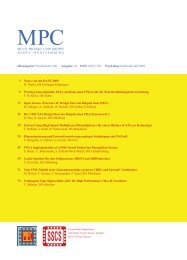
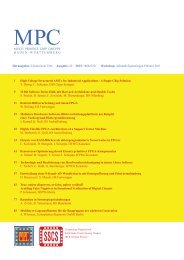
![[Geben Sie hier die Überschrift ein] - MPC](https://img.yumpu.com/8654082/1/188x260/geben-sie-hier-die-uberschrift-ein-mpc.jpg?quality=85)
